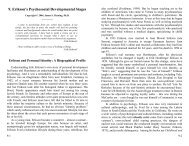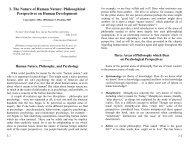7. Piaget, Kohlberg, Gilligan, and Others on Moral Development
7. Piaget, Kohlberg, Gilligan, and Others on Moral Development
7. Piaget, Kohlberg, Gilligan, and Others on Moral Development
You also want an ePaper? Increase the reach of your titles
YUMPU automatically turns print PDFs into web optimized ePapers that Google loves.
punished more severely?<br />
A: Me, because I broke more than <strong>on</strong>e cup.<br />
Clearly this child underst<str<strong>on</strong>g>and</str<strong>on</strong>g> that the boy who broke twelve<br />
cups did not do this intenti<strong>on</strong>ally, yet he still claims that this boy<br />
was more guilty (deserved greater punishment) than the <strong>on</strong>e who<br />
broke just a single cup while doing something he wasn’t supposed<br />
to be doing. Older children <str<strong>on</strong>g>and</str<strong>on</strong>g> adults find his idea of justice<br />
perplexing.<br />
The sec<strong>on</strong>d stage in making moral judgments comes later,<br />
usually around age 10, when children come to realize that rules<br />
have arbitrariness <str<strong>on</strong>g>and</str<strong>on</strong>g> are formed by mutual c<strong>on</strong>sent for reas<strong>on</strong>s of<br />
fairness <str<strong>on</strong>g>and</str<strong>on</strong>g> equity. This applies equally to society’s laws, game<br />
rules, <str<strong>on</strong>g>and</str<strong>on</strong>g> familial st<str<strong>on</strong>g>and</str<strong>on</strong>g>ards of behavior. Older children realize<br />
that rules are not fixed <str<strong>on</strong>g>and</str<strong>on</strong>g> absolute, but that they can be changed<br />
as the need arises. <str<strong>on</strong>g>Piaget</str<strong>on</strong>g> called this sec<strong>on</strong>d stage moral aut<strong>on</strong>omy.<br />
Once again, egocentricism plays into moral heter<strong>on</strong>omy, as the<br />
child is unable to see rules from the broader perspective of another<br />
child or adult, or of society in general. C<strong>on</strong>versely, moral<br />
aut<strong>on</strong>omy requires just such an ability.<br />
<str<strong>on</strong>g>Piaget</str<strong>on</strong>g> also noted that the stages of moral underst<str<strong>on</strong>g>and</str<strong>on</strong>g>ing are not<br />
entirely discreet. Children become capable of certain aut<strong>on</strong>omous<br />
judgments before others, depending <strong>on</strong> the situati<strong>on</strong>, just as<br />
horiz<strong>on</strong>tal décalage characterized the underst<str<strong>on</strong>g>and</str<strong>on</strong>g>ing of his<br />
c<strong>on</strong>servati<strong>on</strong> tasks for cognitive development. In actuality, the<br />
stages of morality overlap <strong>on</strong>e another to some degree.<br />
Gender <str<strong>on</strong>g>and</str<strong>on</strong>g> <strong>Moral</strong> <strong>Development</strong><br />
<str<strong>on</strong>g>Piaget</str<strong>on</strong>g> found that the games that girls played were nowhere<br />
near as complex as the boys <str<strong>on</strong>g>and</str<strong>on</strong>g> their marbles in terms of rules <str<strong>on</strong>g>and</str<strong>on</strong>g><br />
opti<strong>on</strong>s. <str<strong>on</strong>g>Piaget</str<strong>on</strong>g> did compare the stages of morality between the two<br />
sexes, noting both parallels <str<strong>on</strong>g>and</str<strong>on</strong>g> some differences. Both have stages<br />
of moral heter<strong>on</strong>omy <str<strong>on</strong>g>and</str<strong>on</strong>g> aut<strong>on</strong>omy, for example. But the fact that<br />
the girls’ games were simpler makes precise comparis<strong>on</strong>s difficult.<br />
<str<strong>on</strong>g>Piaget</str<strong>on</strong>g> stated that: “The most superficial observati<strong>on</strong> is sufficient to<br />
show that in the main the legal sense is far less developed in little<br />
7-5<br />
girls than in boys. We did not succeed in finding a single collective<br />
game played by girls in which there were as many rules, <str<strong>on</strong>g>and</str<strong>on</strong>g> above<br />
all, as fine <str<strong>on</strong>g>and</str<strong>on</strong>g> c<strong>on</strong>sistent an organizati<strong>on</strong> <str<strong>on</strong>g>and</str<strong>on</strong>g> codificati<strong>on</strong> of these<br />
rules as in the game of marbles . . .” (p. 77). <str<strong>on</strong>g>Piaget</str<strong>on</strong>g> seemed to be<br />
saying that c<strong>on</strong>clusi<strong>on</strong>s gender differences are necessarily tenuous<br />
because the observati<strong>on</strong>s were superficial <str<strong>on</strong>g>and</str<strong>on</strong>g> due to the lack of<br />
opportunity – the girls’ games were simpler, <str<strong>on</strong>g>and</str<strong>on</strong>g> therefore<br />
comparis<strong>on</strong>s were difficult. Yet he did see girls as being less<br />
c<strong>on</strong>cerned with (<str<strong>on</strong>g>and</str<strong>on</strong>g> less rigid about) rules in general, <str<strong>on</strong>g>and</str<strong>on</strong>g> more<br />
ready to relax them: They appeared to be less c<strong>on</strong>cerned with<br />
“legalities.” But elsewhere <str<strong>on</strong>g>Piaget</str<strong>on</strong>g> appeared to equate c<strong>on</strong>cern with<br />
legalities as signs of advanced development: “. . . the juridicomoral<br />
discussi<strong>on</strong>s of the fourth stage [of moral development] may<br />
be compared to formal reas<strong>on</strong>ing in general” (p. 47). Do girls then<br />
have a less sophisticated, <str<strong>on</strong>g>and</str<strong>on</strong>g> therefore deficient sense of moral<br />
underst<str<strong>on</strong>g>and</str<strong>on</strong>g>ing? Carol <str<strong>on</strong>g>Gilligan</str<strong>on</strong>g> (1982) believed that this was<br />
<str<strong>on</strong>g>Piaget</str<strong>on</strong>g>’s message. She criticized <str<strong>on</strong>g>Piaget</str<strong>on</strong>g> <str<strong>on</strong>g>and</str<strong>on</strong>g> other (male)<br />
psychologists of harboring negative views of feminine morality, as<br />
will be seen following a c<strong>on</strong>siderati<strong>on</strong> of Lawrence <str<strong>on</strong>g>Kohlberg</str<strong>on</strong>g>’s<br />
extensi<strong>on</strong> of <str<strong>on</strong>g>Piaget</str<strong>on</strong>g>’s work.<br />
But in defense of <str<strong>on</strong>g>Piaget</str<strong>on</strong>g>, Eliot Turiel (2006, p. 807) noted that<br />
“In c<strong>on</strong>sidering <str<strong>on</strong>g>Piaget</str<strong>on</strong>g>’s ideas, <str<strong>on</strong>g>Gilligan</str<strong>on</strong>g> imposes certainty where<br />
ambiguity exists. <str<strong>on</strong>g>Piaget</str<strong>on</strong>g> did maintain that girls are less interested<br />
than boys in ‘legal elaborati<strong>on</strong>’ <str<strong>on</strong>g>and</str<strong>on</strong>g> that ‘the legal sense is far less<br />
developed in little girls than in boys’ (<str<strong>on</strong>g>Piaget</str<strong>on</strong>g>, 1932[/1962], p. 69 &<br />
75)” but that “. . . in <str<strong>on</strong>g>Piaget</str<strong>on</strong>g>’s view, the developmentally advanced<br />
level of aut<strong>on</strong>omous morality was organized by c<strong>on</strong>cerns with<br />
mutuality, reciprocity, <str<strong>on</strong>g>and</str<strong>on</strong>g> cooperati<strong>on</strong>. <str<strong>on</strong>g>Piaget</str<strong>on</strong>g> saw a strict legal<br />
sense for fixed rules that left little room for innovati<strong>on</strong> <str<strong>on</strong>g>and</str<strong>on</strong>g><br />
tolerance as part of the less advanced form of heter<strong>on</strong>ymous<br />
morality. Thus, it is not at all clear that <str<strong>on</strong>g>Piaget</str<strong>on</strong>g> regarded girls to be<br />
less advanced than girls because he thought that girls were oriented<br />
to tolerance, innovati<strong>on</strong> with rules, <str<strong>on</strong>g>and</str<strong>on</strong>g> cooperati<strong>on</strong>” (p. 807). Thus<br />
<str<strong>on</strong>g>Piaget</str<strong>on</strong>g>’s observati<strong>on</strong>s do suggest that he observed some gender<br />
differences, but these differences are somewhat nuanced; <str<strong>on</strong>g>and</str<strong>on</strong>g><br />
indeed, <strong>on</strong>e could say that he actually saw girls’ moral<br />
underst<str<strong>on</strong>g>and</str<strong>on</strong>g>ing as in some ways actually more advanced than boys’.<br />
7-6




